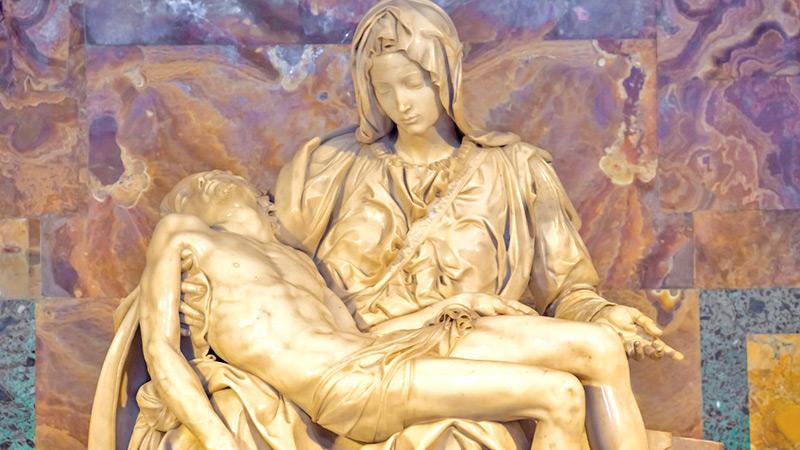
Michelangelo, a famous Italian architect, painter, and sculptor who lived during the Renaissance, considered ‘art’ as his wife and ‘his creations’ as his children. Many of his artworks can still be seen in Rome. He has a special place among several artists who nourished Rome with art. This article is about this wonderful artist and his invaluable gifts to Rome.
 He was born as Michelangelo di Lodevico Buonarotti Simoni on March 6, 1475 in the village of Caprazzi, Florence, to aristocratic parents. He, who was not very good at school, was sent by his father to train under Domenico Giallandaio, a painter who lived in Florence. In 1496, members of the Medici family, a powerful and wealthy family in Florence, who were impressed by the talent of the young Michelangelo, who had studied painting well, brought him to Rome.
He was born as Michelangelo di Lodevico Buonarotti Simoni on March 6, 1475 in the village of Caprazzi, Florence, to aristocratic parents. He, who was not very good at school, was sent by his father to train under Domenico Giallandaio, a painter who lived in Florence. In 1496, members of the Medici family, a powerful and wealthy family in Florence, who were impressed by the talent of the young Michelangelo, who had studied painting well, brought him to Rome.
‘Pieta’
Michelangelo, who came to Rome, created the ‘Pieta’ statue depicting the image of Mother Mary holding Jesus in 1499, and the 17 feet tall ‘David’ statue in 1504. The attention of Pope Julius II was drawn to Michelangelo’s works as a result. Accordingly, the Pope entrusted Michelangelo with the responsibility of painting frescoes in many churches and other related places scattered throughout Rome.
The marble statue, named ‘Pieta’, meaning ‘pity’, was created by Michelangelo when he was only 24 years old. Housed in St. Peter’s Basilica, it was opened for public display in 1500 and is considered one of the ‘Pieta’ trilogy completed by Michelangelo. When asked why Mother Mary was depicted as a young woman in the Pieta, which depicts her holding up Jesus with great mercy and compassion, Michelangelo once stated that women who are pure in body and soul never get old.
Forty five years after the completion of the ‘Pieta’ statue, Michelangelo has returned to St. Peter’s Basilica as the main architect to create the spire. Standing 136.57 metres (448.1 ft) above ground level and with an internal diametre of 41.47 metre (136.1 ft), it is considered the tallest spire in the world.
In 1505, Pope Julius II commissioned Michelangelo to create his tomb, resulting in the completion of the smaller basilica San Pietro in Vincoli 30 years later.
Although Pope Julius II wanted to decorate it with many diamond statues, Pope Leo X, who succeeded him after his death, allowed only three statues to be placed in San Pietro in Vincoli.
The Basilica of San Pietro in Vincoli, designed by Michelangelo as a dedication to his youth, has been described as the ‘mourning of the tomb’. The ‘Moses’ statue with a layer of horns is considered to be a special design there.
Sistine Chapel
A renowned sculptor, Michelangelo was invited by Pope Julius II to paint and shape the ceiling of the Sistine Chapel in May 1508. Michelangelo spent the next four years painting the 12,000-square-foot ceiling of the Sistine Chapel, nine stories from Genesis, and 343 human figures.
The painting depicting ‘God’s creation of Adam’ is considered to be a unique design among them. Later in 1536, Pope Paul III once again invited Michelangelo to the Sistine Chapel to create the ‘Last Judgment’ painting.
It is not wrong to say that the Campidoglio hill, which is considered one of the seven mountain ranges owned by Rome, was an important administrative centre of the Roman Empire for more than 2,000 years.
In 1538, Pope Paul III entrusted Michelangelo with the serious responsibility of giving it a new face as a ploy to win the goodwill of the then Roman Emperor, Charles V. As a result, Michelangelo created the ‘Piazza del Campidoglio’, an oval-shaped city square with a new base for the statue of Marcus Aurelius, who ruled Rome in the 2nd century.
However, it is said that its work was completely finished after the death of Michelangelo.
